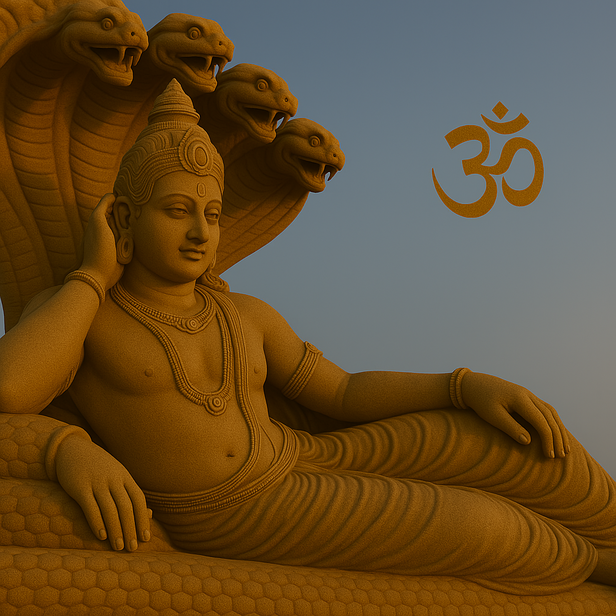Why Lord Vishnu Sleeps on a Serpent – A Cosmic Message We All Missed
Noopur Kumari | Apr 26, 2025, 15:51 IST
lord Vishnu
( Image credit : Times Life Bureau )
Why does the Preserver of the universe choose to rest on a serpent instead of a throne? Hidden beneath Lord Vishnu’s calm, reclining posture lies a powerful story of divine love, cosmic balance, and the silent strength of the Goddess. From the endless coils of Adi Sesha to the stillness of the Ocean of Milk, this article unravels the mystery behind Vishnu’s most misunderstood form. Ready to uncover the truth about his “rest” and the deeper meaning behind this timeless symbol?
Not in slumber, but in divine consciousness, Lord Vishnu lies atop Adi Sesha in the immense silence of the universe. His serene stance represents a profound unification of forces rather than just a place to relax. Vishnu's poised serenity signifies balance in the midst of chaos, while the coiled serpent stands for endless time and silent might. The feminine energy—Goddess Lakshmi, sitting at his feet, nourishing the universe with invisible grace—lies beneath this tranquility.

Beneath Adi Sesha's ferocious, snake-like exterior is a delicate truth: he gives timeless wisdom rather than fear. He calmly holds the universe together while the unending one coils through space and time. The peaceful repose of Lord Vishnu on him is not solace; rather, it is submission to Shakti, the coiled feminine energy at the centre of everything. Sesha represents patience, balance, and sacred quiet in addition to being a serpent. All is entrusted to this silent power by Vishnu, the Preserver. We catch a glimpse of a potent secret in that holy stillness: real creation starts at the point where the masculine gives way to the feminine.

Lord Vishnu lies atop Kshira Sagara, the Ocean of Milk, the silent, holy womb of the universe, rather than just water. This sea is not your typical sea; it is the goddess herself, invisible and unsaid but the origin of everything that has ever existed or will exist. She has boundless potential in her silent depths, only waiting to give birth to universes. Vishnu's silence over her is a sign of total faith in the divine feminine, not of disinterest. Her quiet is the hallowed interval before creation sings, not emptiness. He finds the strength to hold onto everything that comes out of her unending hug by giving himself over to her silence.

The majority of us think that Lord Vishnu is dozing off and floating atop Adi Sesha. But take a closer look—instead of resting, he is meditating and waiting in silence for the Goddess Mahamaya to whisper in order to start the next cycle of creation. Vishnu's silence is not indolence; rather, it is complete surrender, like a seed waiting for rain or a warrior waiting for his queen's order. Devotion, faith, and heavenly readiness are all present in that holy moment. He waits with a sense of cosmic love rather than helplessness, understanding that actual creation won't start until Shakti gives the all-clear.
Goddess Lakshmi's foot massages of Vishnu might initially appear to be a sign of submission. Examine it more closely, though; it is supernatural empowerment. She is the power that keeps him going, not beneath him. Vishnu, the Preserver, rests not in power but in modest recognition that even gods are powerless to preserve the universe without Lakshmi's nourishing kindness. He is cradled by the ocean, the goddess, and the snake, all of which are Shakti. He listens to their rhythm and their quiet force as he sits motionless. This isn't relaxation. This is respect for the feminine, where love, balance, and creation come from letting go rather than from exerting control.

Why does Vishnu not appear to be soaring or towering tall on Garuda? His actual strength is found in stillness rather than movement. The ultimate gesture of confidence and submission to divine timing is to recline; it is not a sign of weakness. Vishnu reminds us of the divine strength in just being, in receiving rather than conquering, in a world that is driven by activity. As Shiva dances and Brahma produces, Vishnu, who is held by Shakti and connected with the goddess, rests. "I believe. I trust," his silence conveys. His heavenly anchor is that. His silent demeanour conveys a lesson to all of us: waiting with faith might occasionally be the most potent deed of all.

Adi Sesha's silence—not emptiness, but boundless possibilities—existed before the first echoes of "Om" reverberated throughout the universe. The breath before the song, the pause before the poem. And atop that holy silence lies Vishnu, the everlasting Preserver. His serenity comes from listening intently and having faith in the divine cycle of creation, not from doing nothing. He waits—for the Goddess to stir, for Shakti to awaken, rather than acting rashly. The universe doesn't flourish till then. The secret is in that silence: the whisper of the divine feminine, the calm, and the submission are the sources of all creation.

More than just a work of sublime art, the picture of Lord Vishnu lounging on Adi Sesha represents a spiritual message. Vishnu reveals a deeper truth in a world that is fixated on motion, speed, and never-ending doing: true strength is found in stillness. His divine rest consists of faith, letting go to the peaceful force of the feminine and letting life unfold naturally. Sometimes pausing, being, and waiting gracefully are the most brave things one can do. Resting in truth is wisdom, not weakness, like Vishnu on the coils of the serpent. The biggest changes happen in silence.
So, the next time you see Lord Vishnu reclining on the serpent in the vast ocean, don’t just see a god at rest. See a divine man trusting the feminine, see a cosmic silence birthing galaxies, and see a posture of power, love, and infinite wisdom. Because sometimes, doing nothing is the most powerful thing you can do — when you do it with faith in the goddess.
Explore the latest trends and tips in Health & Fitness, Travel, Life Hacks, Fashion & Beauty, and Relationships at Times Life
1. Adi Sesha: The Serpent That Isn’t Just a Snake

Adi Sesha
( Image credit : Times Life Bureau )
Beneath Adi Sesha's ferocious, snake-like exterior is a delicate truth: he gives timeless wisdom rather than fear. He calmly holds the universe together while the unending one coils through space and time. The peaceful repose of Lord Vishnu on him is not solace; rather, it is submission to Shakti, the coiled feminine energy at the centre of everything. Sesha represents patience, balance, and sacred quiet in addition to being a serpent. All is entrusted to this silent power by Vishnu, the Preserver. We catch a glimpse of a potent secret in that holy stillness: real creation starts at the point where the masculine gives way to the feminine.
2. The Cosmic Ocean: It’s Not Water, It’s the Womb of the Goddess

Ocean of Milk,
( Image credit : Times Life Bureau )
Lord Vishnu lies atop Kshira Sagara, the Ocean of Milk, the silent, holy womb of the universe, rather than just water. This sea is not your typical sea; it is the goddess herself, invisible and unsaid but the origin of everything that has ever existed or will exist. She has boundless potential in her silent depths, only waiting to give birth to universes. Vishnu's silence over her is a sign of total faith in the divine feminine, not of disinterest. Her quiet is the hallowed interval before creation sings, not emptiness. He finds the strength to hold onto everything that comes out of her unending hug by giving himself over to her silence.
3. Vishnu Isn’t Sleeping – He’s Waiting for Her Signal

Adi Sesha.
( Image credit : Times Life Bureau )
The majority of us think that Lord Vishnu is dozing off and floating atop Adi Sesha. But take a closer look—instead of resting, he is meditating and waiting in silence for the Goddess Mahamaya to whisper in order to start the next cycle of creation. Vishnu's silence is not indolence; rather, it is complete surrender, like a seed waiting for rain or a warrior waiting for his queen's order. Devotion, faith, and heavenly readiness are all present in that holy moment. He waits with a sense of cosmic love rather than helplessness, understanding that actual creation won't start until Shakti gives the all-clear.
4. Lakshmi’s Presence on His Feet: The Real Seat of Power

Goddess Lakshmi'
( Image credit : Times Life Bureau )
Goddess Lakshmi's foot massages of Vishnu might initially appear to be a sign of submission. Examine it more closely, though; it is supernatural empowerment. She is the power that keeps him going, not beneath him. Vishnu, the Preserver, rests not in power but in modest recognition that even gods are powerless to preserve the universe without Lakshmi's nourishing kindness. He is cradled by the ocean, the goddess, and the snake, all of which are Shakti. He listens to their rhythm and their quiet force as he sits motionless. This isn't relaxation. This is respect for the feminine, where love, balance, and creation come from letting go rather than from exerting control.
5. The Posture of Recline: The Feminine Act of Receiving

Goddess Lakshmi'
( Image credit : Times Life Bureau )
Why does Vishnu not appear to be soaring or towering tall on Garuda? His actual strength is found in stillness rather than movement. The ultimate gesture of confidence and submission to divine timing is to recline; it is not a sign of weakness. Vishnu reminds us of the divine strength in just being, in receiving rather than conquering, in a world that is driven by activity. As Shiva dances and Brahma produces, Vishnu, who is held by Shakti and connected with the goddess, rests. "I believe. I trust," his silence conveys. His heavenly anchor is that. His silent demeanour conveys a lesson to all of us: waiting with faith might occasionally be the most potent deed of all.
6. Adi Sesha, the First Listener of Om: Silence Before Creation

Adi Sesha's silence
( Image credit : Times Life Bureau )
Adi Sesha's silence—not emptiness, but boundless possibilities—existed before the first echoes of "Om" reverberated throughout the universe. The breath before the song, the pause before the poem. And atop that holy silence lies Vishnu, the everlasting Preserver. His serenity comes from listening intently and having faith in the divine cycle of creation, not from doing nothing. He waits—for the Goddess to stir, for Shakti to awaken, rather than acting rashly. The universe doesn't flourish till then. The secret is in that silence: the whisper of the divine feminine, the calm, and the submission are the sources of all creation.
7. What This Means for Us: Embrace Your Inner Stillness

Vishnu
( Image credit : Times Life Bureau )
More than just a work of sublime art, the picture of Lord Vishnu lounging on Adi Sesha represents a spiritual message. Vishnu reveals a deeper truth in a world that is fixated on motion, speed, and never-ending doing: true strength is found in stillness. His divine rest consists of faith, letting go to the peaceful force of the feminine and letting life unfold naturally. Sometimes pausing, being, and waiting gracefully are the most brave things one can do. Resting in truth is wisdom, not weakness, like Vishnu on the coils of the serpent. The biggest changes happen in silence.
The Silent Throne Is Not Empty – It’s Sacred
Explore the latest trends and tips in Health & Fitness, Travel, Life Hacks, Fashion & Beauty, and Relationships at Times Life
